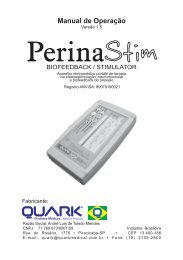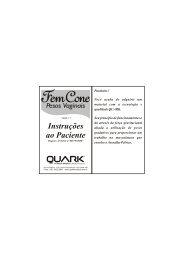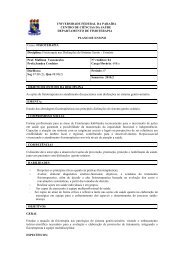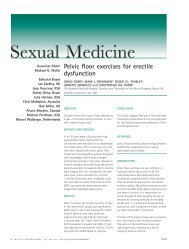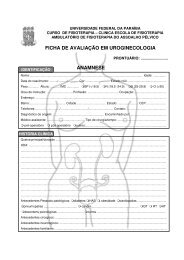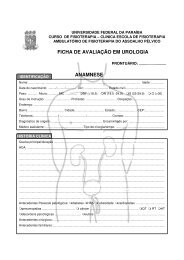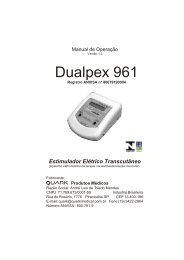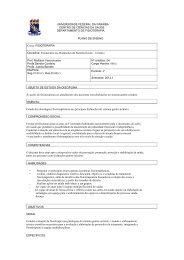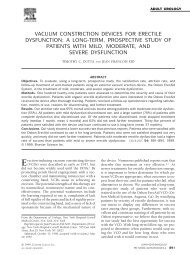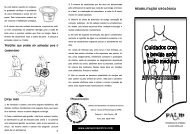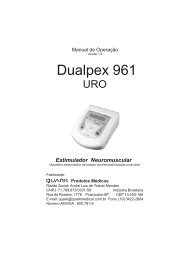Sacral neuromodulation for the treatment of refractory urinary urge ...
Sacral neuromodulation for the treatment of refractory urinary urge ...
Sacral neuromodulation for the treatment of refractory urinary urge ...
You also want an ePaper? Increase the reach of your titles
YUMPU automatically turns print PDFs into web optimized ePapers that Google loves.
Sherman et al 2085<br />
Table I Surgical history <strong>of</strong> responders versus nonresponders<br />
Characteristics N Responders (%) Nonresponders (%) P-value<br />
Age O55 y 34 59.1 100.0 .01<br />
Time since incontinence s<strong>urge</strong>ry (O4 y) 30 13.6 62.5 .01<br />
Incontinence s<strong>urge</strong>ries 34<br />
PVS 8 22.7 25.0<br />
PVS and prolapse repair 10 31.8 25.0 .95<br />
PVS and sling incision 9 27.3 25.0<br />
O<strong>the</strong>r: 7 18.2 25.0<br />
Burch (with repair) 3<br />
Collagen 3<br />
Needle suspension<br />
PVS, Pubovaginal sling.<br />
1<br />
and release was per<strong>for</strong>med were not statistically significant<br />
factors between responders and nonresponders<br />
(Table I).<br />
Because a younger age has been previously shown to<br />
be an independent variable <strong>for</strong> success with sacral<br />
<strong>neuromodulation</strong> 7 and this was reproduced in our study,<br />
we re-evaluated previously determined variables using<br />
<strong>the</strong> age <strong>of</strong> 55 as a cut<strong>of</strong>f between <strong>the</strong> 2 groups. The only<br />
parameter that was statistically significant between <strong>the</strong><br />
2 groups was that women older than 55, who responded<br />
to sacral <strong>neuromodulation</strong>, had more IE per day than<br />
<strong>the</strong> younger responders. All urodynamic and incontinence<br />
symptom parameters were similar. Interestingly,<br />
whe<strong>the</strong>r <strong>the</strong> woman was young or old, few responded to<br />
sacral <strong>neuromodulation</strong> if <strong>the</strong>ir s<strong>urge</strong>ry had been<br />
per<strong>for</strong>med more than 4 years be<strong>for</strong>e <strong>the</strong> test stimulation<br />
procedure (Table II).<br />
All <strong>the</strong> nonresponders were in <strong>the</strong> group <strong>of</strong> women<br />
older than 55 years. When one compared this older<br />
group <strong>of</strong> responders and nonresponders, lack <strong>of</strong> pelvic<br />
floor muscular activity best correlated with nonresponding<br />
to sacral <strong>neuromodulation</strong> (Table III). After logistic<br />
regression, if <strong>the</strong> woman is older than 55 years with no<br />
pelvic floor activity, she has a 100% chance <strong>of</strong> not<br />
responding to sacral <strong>neuromodulation</strong> in this cohort <strong>of</strong><br />
women (Table IV).<br />
Comment<br />
The incidence <strong>of</strong> OAB symptoms after SUI s<strong>urge</strong>ry<br />
depends on <strong>the</strong> surgical technique used, and can be as<br />
high as 31%, although usually less than 10%. 12-15 Even<br />
with <strong>the</strong> newer minimally invasive approaches <strong>for</strong> stress<br />
incontinence, <strong>the</strong> risk <strong>of</strong> OAB symptoms postoperatively<br />
persists. In this study, 7 <strong>of</strong> <strong>the</strong> 28 slings were<br />
placed by using a minimally invasive technique. Although<br />
SUI may be resolved, <strong>the</strong> presence <strong>of</strong> OAB<br />
symptoms proves to be a source <strong>of</strong> continued patient<br />
dissatisfaction after incontinence procedures. 13,16<br />
It is not clear why OAB symptoms sometimes occur<br />
after stress incontinence procedures. Possible causes<br />
Figure Age distribution <strong>of</strong> responders and non-responders.<br />
include undiscovered preexisting detrusor overactivity,<br />
a neurogenic dysfunction resulting from surgical interference<br />
with autonomic bladder innervation, increased<br />
striated urethral sphincter activity, or structural urethral<br />
obstruction. 17-20 In <strong>the</strong> latter, sling incision and revision<br />
or o<strong>the</strong>r urethrolysis procedures are considered. In <strong>the</strong>se<br />
cases, postoperative voiding symptoms (frequency, <strong>urge</strong>ncy,<br />
and <strong>urge</strong> incontinence) occur in conjunction with<br />
<strong>the</strong> finding <strong>of</strong> a retropexed urethra and/or an obstructive<br />
voiding pattern on urodynamics. One third <strong>of</strong> <strong>the</strong><br />
women in our study group had undergone sling release<br />
that had relieved obstructive voiding symptoms but<br />
OAB symptoms had persisted. Interestingly, having had<br />
a sling incision and release did not affect response to<br />
<strong>neuromodulation</strong>.<br />
The mechanism by which <strong>neuromodulation</strong> works<br />
is not completely understood, it has been shown to be<br />
efficacious in idiopathic <strong>refractory</strong> <strong>urge</strong> incontinence<br />
and nonobstructive <strong>urinary</strong> retention. 6,21 It is believed<br />
that <strong>neuromodulation</strong> treats bladder overactivity by<br />
altering <strong>the</strong> activity and basal tone <strong>of</strong> <strong>the</strong> pelvic floor<br />
as well as modulating <strong>the</strong> afferent signals delivered to<br />
<strong>the</strong> spinal cord. 22 The cause <strong>of</strong> nonobstructive <strong>urinary</strong>





